Comparative Analysis of Financial Statements of ANZ Bank and Commonwealth Bank
VerifiedAdded on 2022/11/28
|15
|3125
|114
AI Summary
This report evaluates and compares the financial statements of ANZ Bank and Commonwealth Bank, focusing on the elements of balance sheet such as liabilities and equity. It also discusses the legal compliance and government regulations for necessary reporting. The report provides insights into the capital structure, reserves, retained earnings, and non-controlling interests of both banks. It also analyzes the liabilities section, including deposits, borrowings, and provisions. The report concludes with a discussion on small proprietary companies, large proprietary companies, and disclosing entities.
Contribute Materials
Your contribution can guide someone’s learning journey. Share your
documents today.
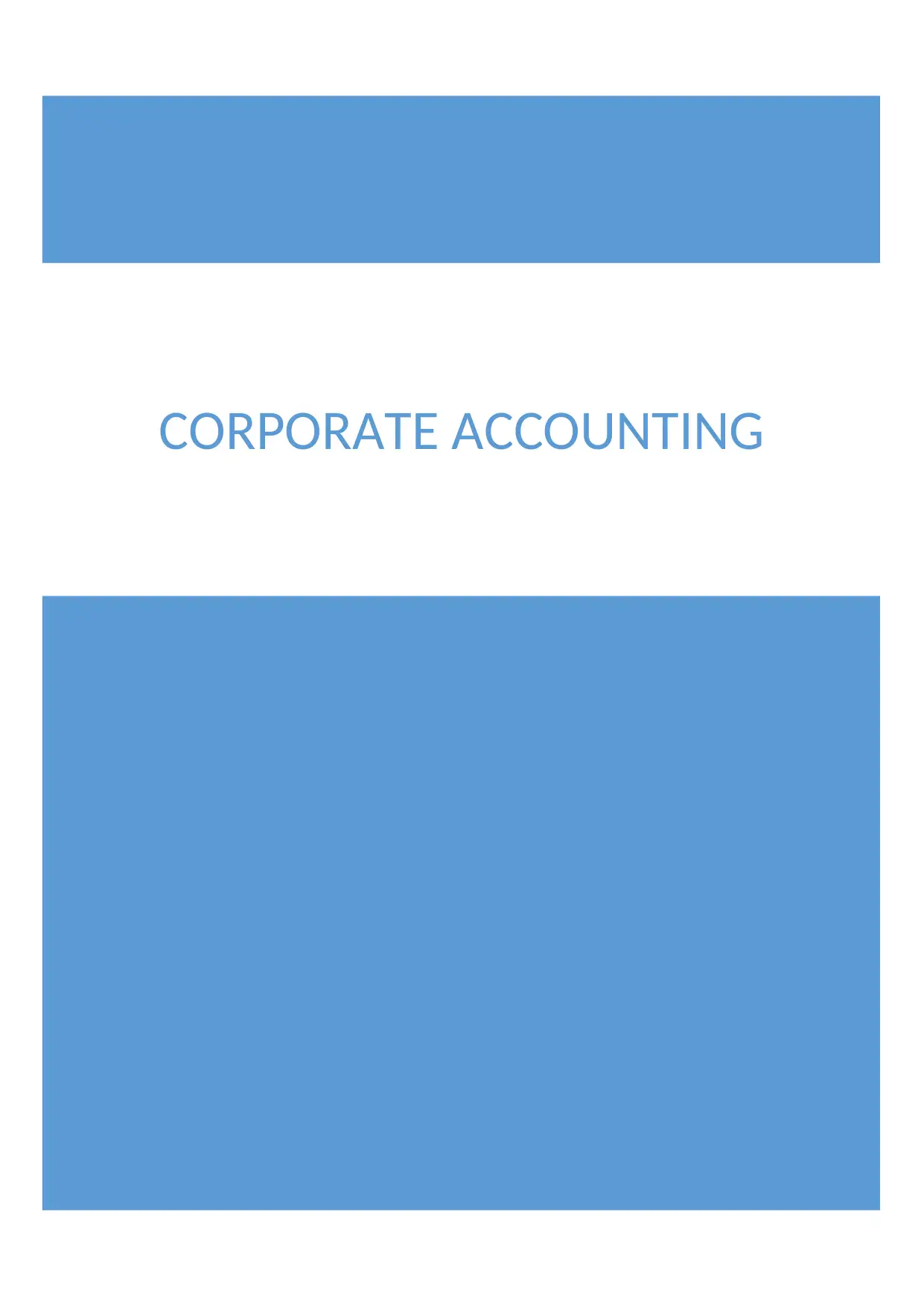
CORPORATE ACCOUNTING
Secure Best Marks with AI Grader
Need help grading? Try our AI Grader for instant feedback on your assignments.
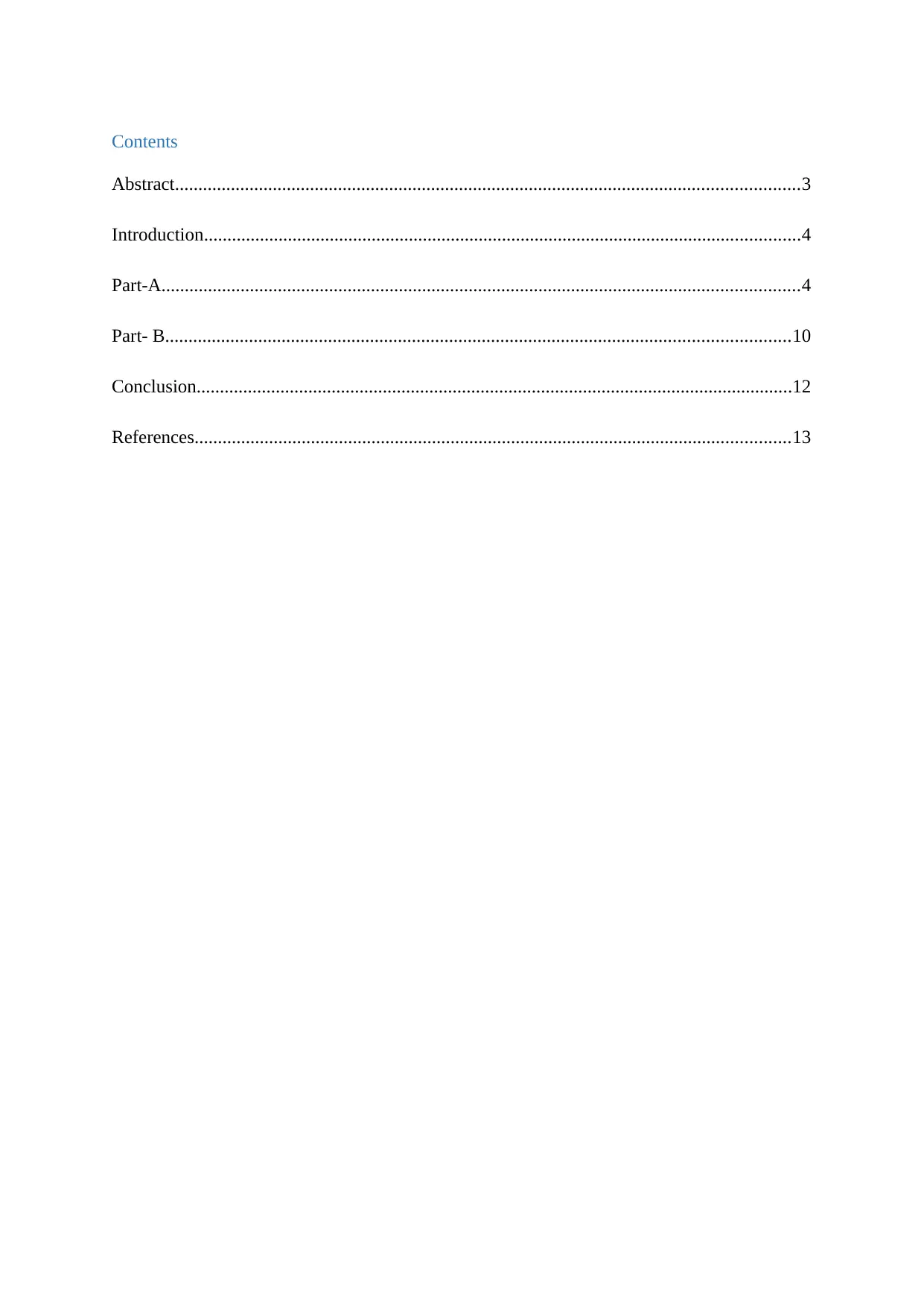
Contents
Abstract......................................................................................................................................3
Introduction................................................................................................................................4
Part-A.........................................................................................................................................4
Part- B......................................................................................................................................10
Conclusion................................................................................................................................12
References................................................................................................................................13
Abstract......................................................................................................................................3
Introduction................................................................................................................................4
Part-A.........................................................................................................................................4
Part- B......................................................................................................................................10
Conclusion................................................................................................................................12
References................................................................................................................................13
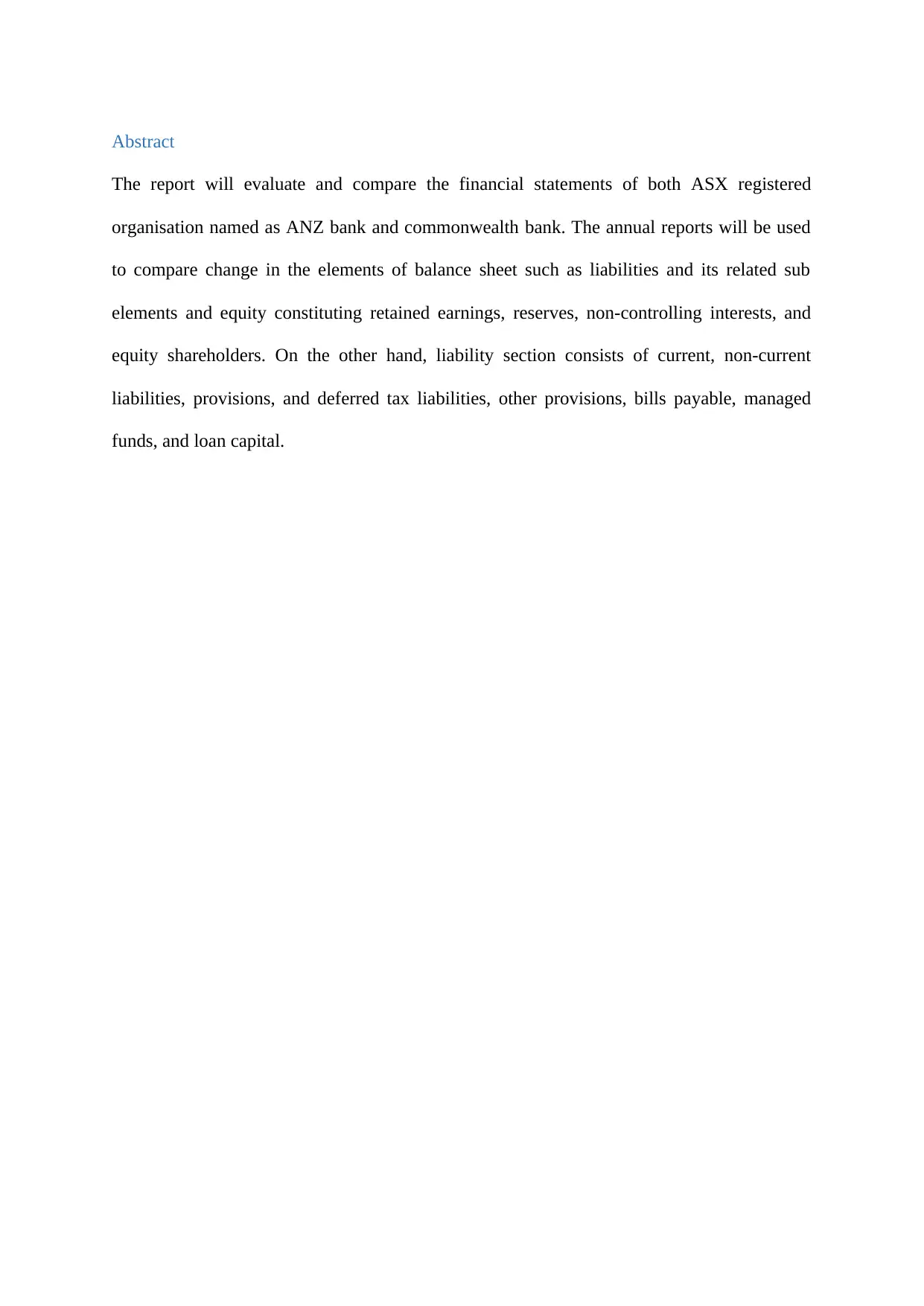
Abstract
The report will evaluate and compare the financial statements of both ASX registered
organisation named as ANZ bank and commonwealth bank. The annual reports will be used
to compare change in the elements of balance sheet such as liabilities and its related sub
elements and equity constituting retained earnings, reserves, non-controlling interests, and
equity shareholders. On the other hand, liability section consists of current, non-current
liabilities, provisions, and deferred tax liabilities, other provisions, bills payable, managed
funds, and loan capital.
The report will evaluate and compare the financial statements of both ASX registered
organisation named as ANZ bank and commonwealth bank. The annual reports will be used
to compare change in the elements of balance sheet such as liabilities and its related sub
elements and equity constituting retained earnings, reserves, non-controlling interests, and
equity shareholders. On the other hand, liability section consists of current, non-current
liabilities, provisions, and deferred tax liabilities, other provisions, bills payable, managed
funds, and loan capital.
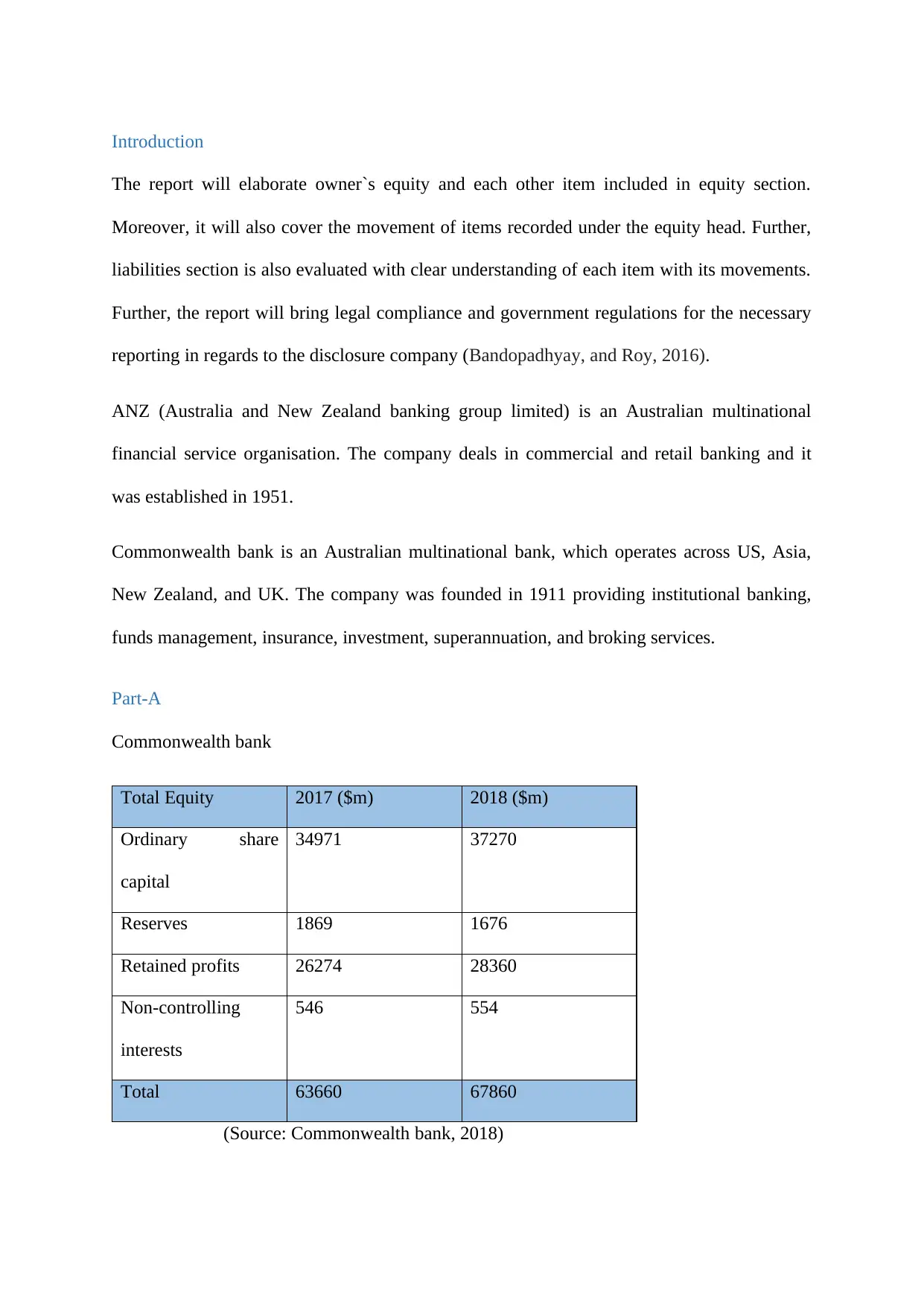
Introduction
The report will elaborate owner`s equity and each other item included in equity section.
Moreover, it will also cover the movement of items recorded under the equity head. Further,
liabilities section is also evaluated with clear understanding of each item with its movements.
Further, the report will bring legal compliance and government regulations for the necessary
reporting in regards to the disclosure company (Bandopadhyay, and Roy, 2016).
ANZ (Australia and New Zealand banking group limited) is an Australian multinational
financial service organisation. The company deals in commercial and retail banking and it
was established in 1951.
Commonwealth bank is an Australian multinational bank, which operates across US, Asia,
New Zealand, and UK. The company was founded in 1911 providing institutional banking,
funds management, insurance, investment, superannuation, and broking services.
Part-A
Commonwealth bank
Total Equity 2017 ($m) 2018 ($m)
Ordinary share
capital
34971 37270
Reserves 1869 1676
Retained profits 26274 28360
Non-controlling
interests
546 554
Total 63660 67860
(Source: Commonwealth bank, 2018)
The report will elaborate owner`s equity and each other item included in equity section.
Moreover, it will also cover the movement of items recorded under the equity head. Further,
liabilities section is also evaluated with clear understanding of each item with its movements.
Further, the report will bring legal compliance and government regulations for the necessary
reporting in regards to the disclosure company (Bandopadhyay, and Roy, 2016).
ANZ (Australia and New Zealand banking group limited) is an Australian multinational
financial service organisation. The company deals in commercial and retail banking and it
was established in 1951.
Commonwealth bank is an Australian multinational bank, which operates across US, Asia,
New Zealand, and UK. The company was founded in 1911 providing institutional banking,
funds management, insurance, investment, superannuation, and broking services.
Part-A
Commonwealth bank
Total Equity 2017 ($m) 2018 ($m)
Ordinary share
capital
34971 37270
Reserves 1869 1676
Retained profits 26274 28360
Non-controlling
interests
546 554
Total 63660 67860
(Source: Commonwealth bank, 2018)
Secure Best Marks with AI Grader
Need help grading? Try our AI Grader for instant feedback on your assignments.
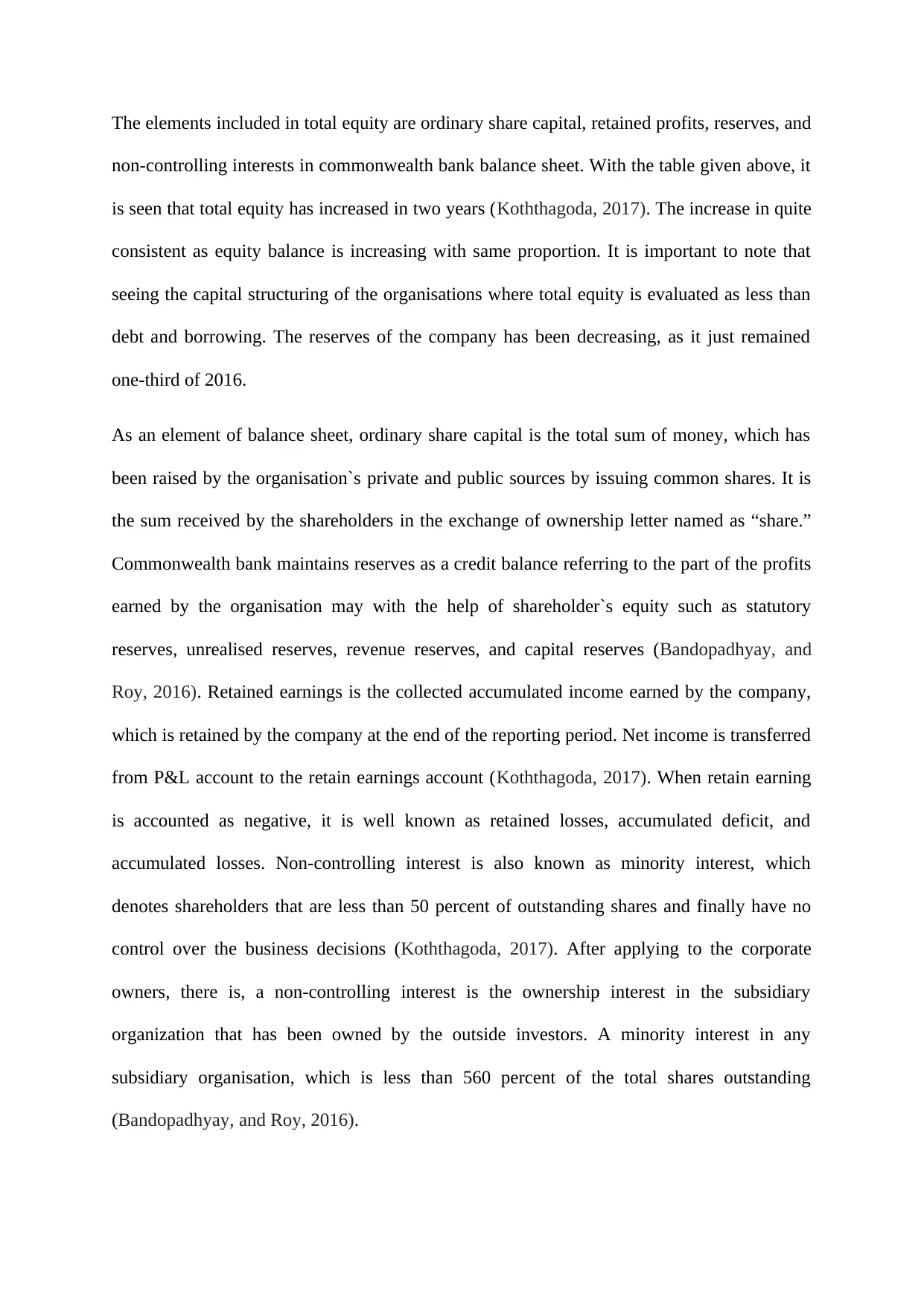
The elements included in total equity are ordinary share capital, retained profits, reserves, and
non-controlling interests in commonwealth bank balance sheet. With the table given above, it
is seen that total equity has increased in two years (Koththagoda, 2017). The increase in quite
consistent as equity balance is increasing with same proportion. It is important to note that
seeing the capital structuring of the organisations where total equity is evaluated as less than
debt and borrowing. The reserves of the company has been decreasing, as it just remained
one-third of 2016.
As an element of balance sheet, ordinary share capital is the total sum of money, which has
been raised by the organisation`s private and public sources by issuing common shares. It is
the sum received by the shareholders in the exchange of ownership letter named as “share.”
Commonwealth bank maintains reserves as a credit balance referring to the part of the profits
earned by the organisation may with the help of shareholder`s equity such as statutory
reserves, unrealised reserves, revenue reserves, and capital reserves (Bandopadhyay, and
Roy, 2016). Retained earnings is the collected accumulated income earned by the company,
which is retained by the company at the end of the reporting period. Net income is transferred
from P&L account to the retain earnings account (Koththagoda, 2017). When retain earning
is accounted as negative, it is well known as retained losses, accumulated deficit, and
accumulated losses. Non-controlling interest is also known as minority interest, which
denotes shareholders that are less than 50 percent of outstanding shares and finally have no
control over the business decisions (Koththagoda, 2017). After applying to the corporate
owners, there is, a non-controlling interest is the ownership interest in the subsidiary
organization that has been owned by the outside investors. A minority interest in any
subsidiary organisation, which is less than 560 percent of the total shares outstanding
(Bandopadhyay, and Roy, 2016).
non-controlling interests in commonwealth bank balance sheet. With the table given above, it
is seen that total equity has increased in two years (Koththagoda, 2017). The increase in quite
consistent as equity balance is increasing with same proportion. It is important to note that
seeing the capital structuring of the organisations where total equity is evaluated as less than
debt and borrowing. The reserves of the company has been decreasing, as it just remained
one-third of 2016.
As an element of balance sheet, ordinary share capital is the total sum of money, which has
been raised by the organisation`s private and public sources by issuing common shares. It is
the sum received by the shareholders in the exchange of ownership letter named as “share.”
Commonwealth bank maintains reserves as a credit balance referring to the part of the profits
earned by the organisation may with the help of shareholder`s equity such as statutory
reserves, unrealised reserves, revenue reserves, and capital reserves (Bandopadhyay, and
Roy, 2016). Retained earnings is the collected accumulated income earned by the company,
which is retained by the company at the end of the reporting period. Net income is transferred
from P&L account to the retain earnings account (Koththagoda, 2017). When retain earning
is accounted as negative, it is well known as retained losses, accumulated deficit, and
accumulated losses. Non-controlling interest is also known as minority interest, which
denotes shareholders that are less than 50 percent of outstanding shares and finally have no
control over the business decisions (Koththagoda, 2017). After applying to the corporate
owners, there is, a non-controlling interest is the ownership interest in the subsidiary
organization that has been owned by the outside investors. A minority interest in any
subsidiary organisation, which is less than 560 percent of the total shares outstanding
(Bandopadhyay, and Roy, 2016).
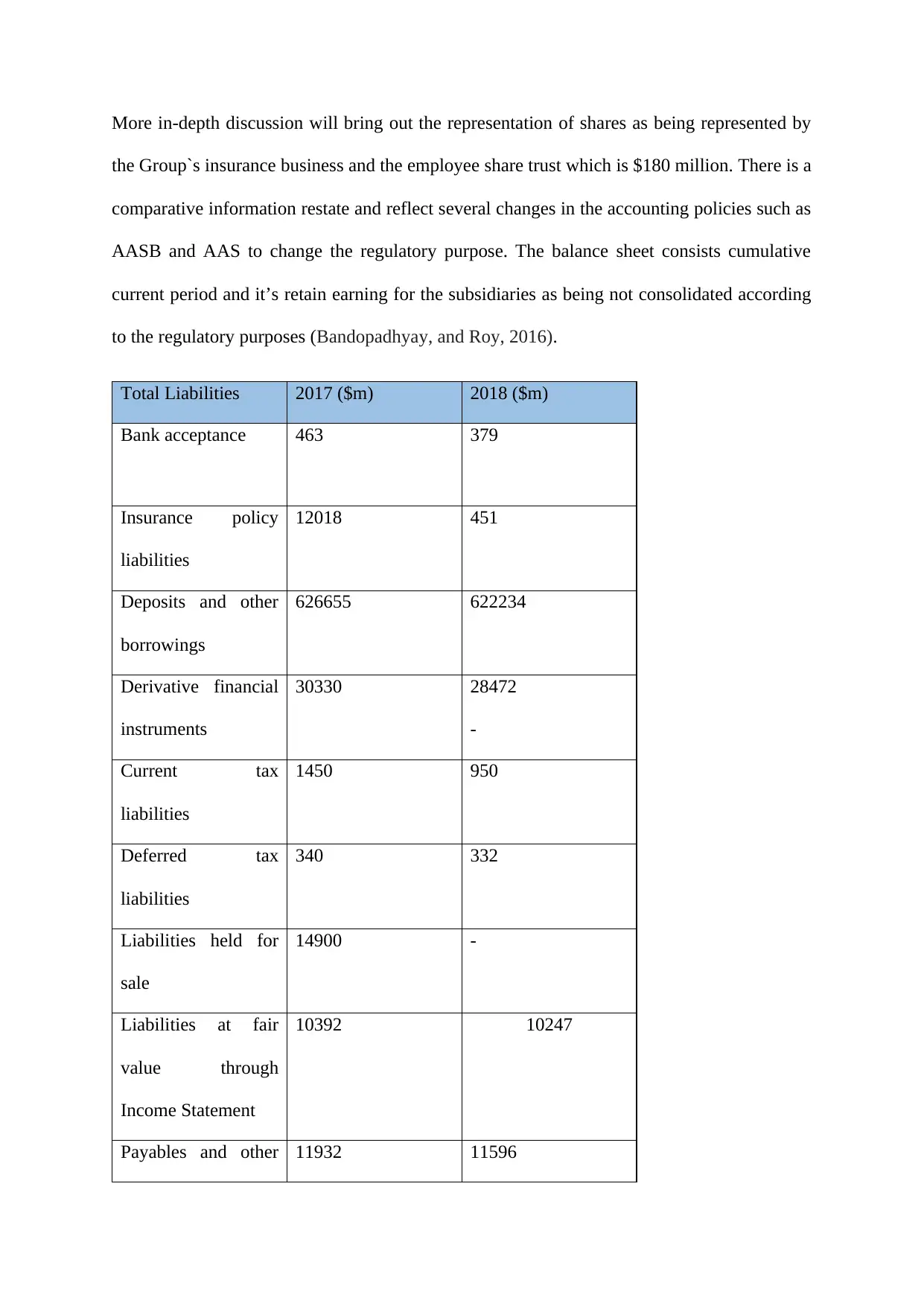
More in-depth discussion will bring out the representation of shares as being represented by
the Group`s insurance business and the employee share trust which is $180 million. There is a
comparative information restate and reflect several changes in the accounting policies such as
AASB and AAS to change the regulatory purpose. The balance sheet consists cumulative
current period and it’s retain earning for the subsidiaries as being not consolidated according
to the regulatory purposes (Bandopadhyay, and Roy, 2016).
Total Liabilities 2017 ($m) 2018 ($m)
Bank acceptance 463 379
Insurance policy
liabilities
12018 451
Deposits and other
borrowings
626655 622234
Derivative financial
instruments
30330 28472
-
Current tax
liabilities
1450 950
Deferred tax
liabilities
340 332
Liabilities held for
sale
14900 -
Liabilities at fair
value through
Income Statement
10392 10247
Payables and other 11932 11596
the Group`s insurance business and the employee share trust which is $180 million. There is a
comparative information restate and reflect several changes in the accounting policies such as
AASB and AAS to change the regulatory purpose. The balance sheet consists cumulative
current period and it’s retain earning for the subsidiaries as being not consolidated according
to the regulatory purposes (Bandopadhyay, and Roy, 2016).
Total Liabilities 2017 ($m) 2018 ($m)
Bank acceptance 463 379
Insurance policy
liabilities
12018 451
Deposits and other
borrowings
626655 622234
Derivative financial
instruments
30330 28472
-
Current tax
liabilities
1450 950
Deferred tax
liabilities
340 332
Liabilities held for
sale
14900 -
Liabilities at fair
value through
Income Statement
10392 10247
Payables and other 11932 11596
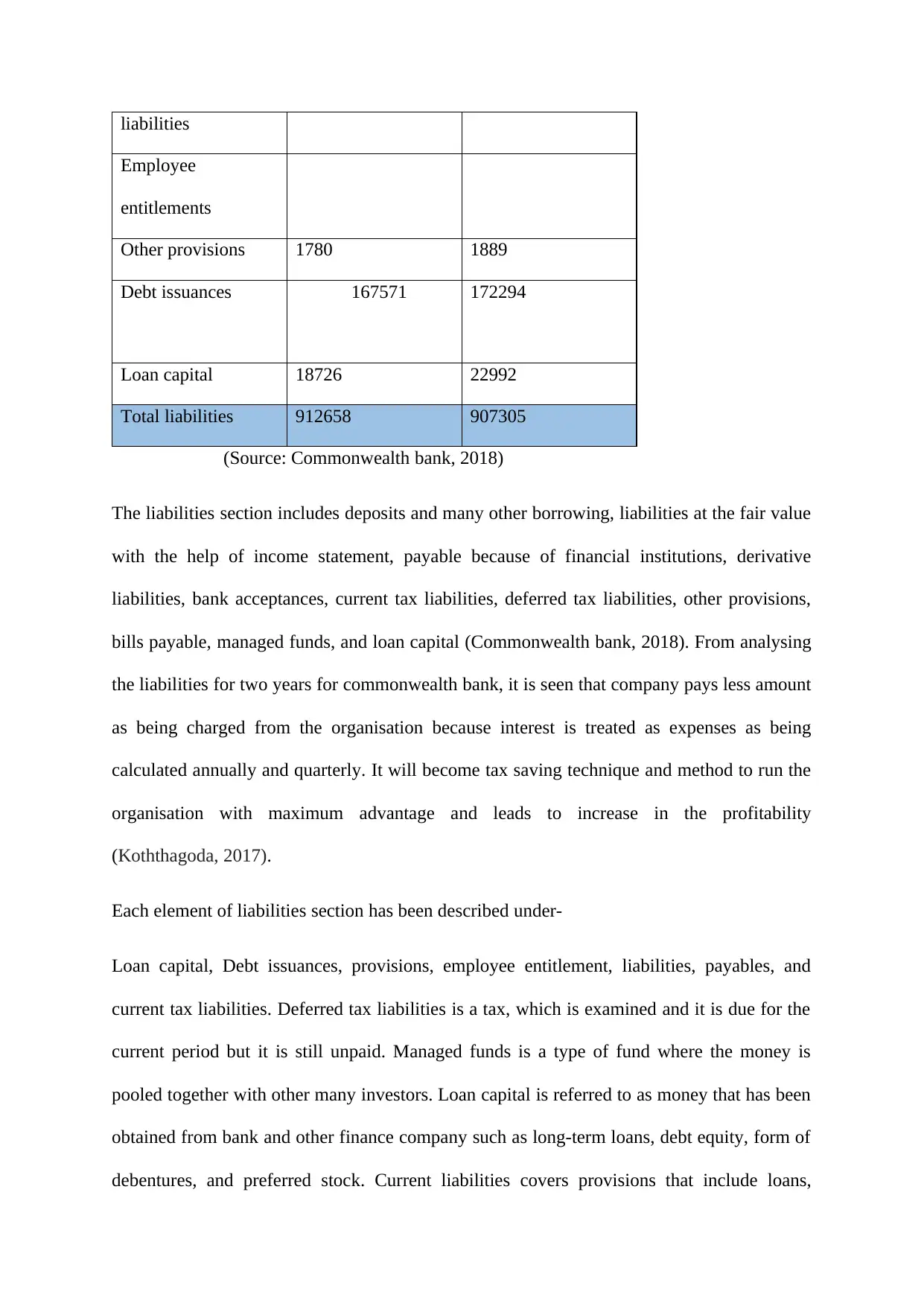
liabilities
Employee
entitlements
Other provisions 1780 1889
Debt issuances 167571 172294
Loan capital 18726 22992
Total liabilities 912658 907305
(Source: Commonwealth bank, 2018)
The liabilities section includes deposits and many other borrowing, liabilities at the fair value
with the help of income statement, payable because of financial institutions, derivative
liabilities, bank acceptances, current tax liabilities, deferred tax liabilities, other provisions,
bills payable, managed funds, and loan capital (Commonwealth bank, 2018). From analysing
the liabilities for two years for commonwealth bank, it is seen that company pays less amount
as being charged from the organisation because interest is treated as expenses as being
calculated annually and quarterly. It will become tax saving technique and method to run the
organisation with maximum advantage and leads to increase in the profitability
(Koththagoda, 2017).
Each element of liabilities section has been described under-
Loan capital, Debt issuances, provisions, employee entitlement, liabilities, payables, and
current tax liabilities. Deferred tax liabilities is a tax, which is examined and it is due for the
current period but it is still unpaid. Managed funds is a type of fund where the money is
pooled together with other many investors. Loan capital is referred to as money that has been
obtained from bank and other finance company such as long-term loans, debt equity, form of
debentures, and preferred stock. Current liabilities covers provisions that include loans,
Employee
entitlements
Other provisions 1780 1889
Debt issuances 167571 172294
Loan capital 18726 22992
Total liabilities 912658 907305
(Source: Commonwealth bank, 2018)
The liabilities section includes deposits and many other borrowing, liabilities at the fair value
with the help of income statement, payable because of financial institutions, derivative
liabilities, bank acceptances, current tax liabilities, deferred tax liabilities, other provisions,
bills payable, managed funds, and loan capital (Commonwealth bank, 2018). From analysing
the liabilities for two years for commonwealth bank, it is seen that company pays less amount
as being charged from the organisation because interest is treated as expenses as being
calculated annually and quarterly. It will become tax saving technique and method to run the
organisation with maximum advantage and leads to increase in the profitability
(Koththagoda, 2017).
Each element of liabilities section has been described under-
Loan capital, Debt issuances, provisions, employee entitlement, liabilities, payables, and
current tax liabilities. Deferred tax liabilities is a tax, which is examined and it is due for the
current period but it is still unpaid. Managed funds is a type of fund where the money is
pooled together with other many investors. Loan capital is referred to as money that has been
obtained from bank and other finance company such as long-term loans, debt equity, form of
debentures, and preferred stock. Current liabilities covers provisions that include loans,
Paraphrase This Document
Need a fresh take? Get an instant paraphrase of this document with our AI Paraphraser
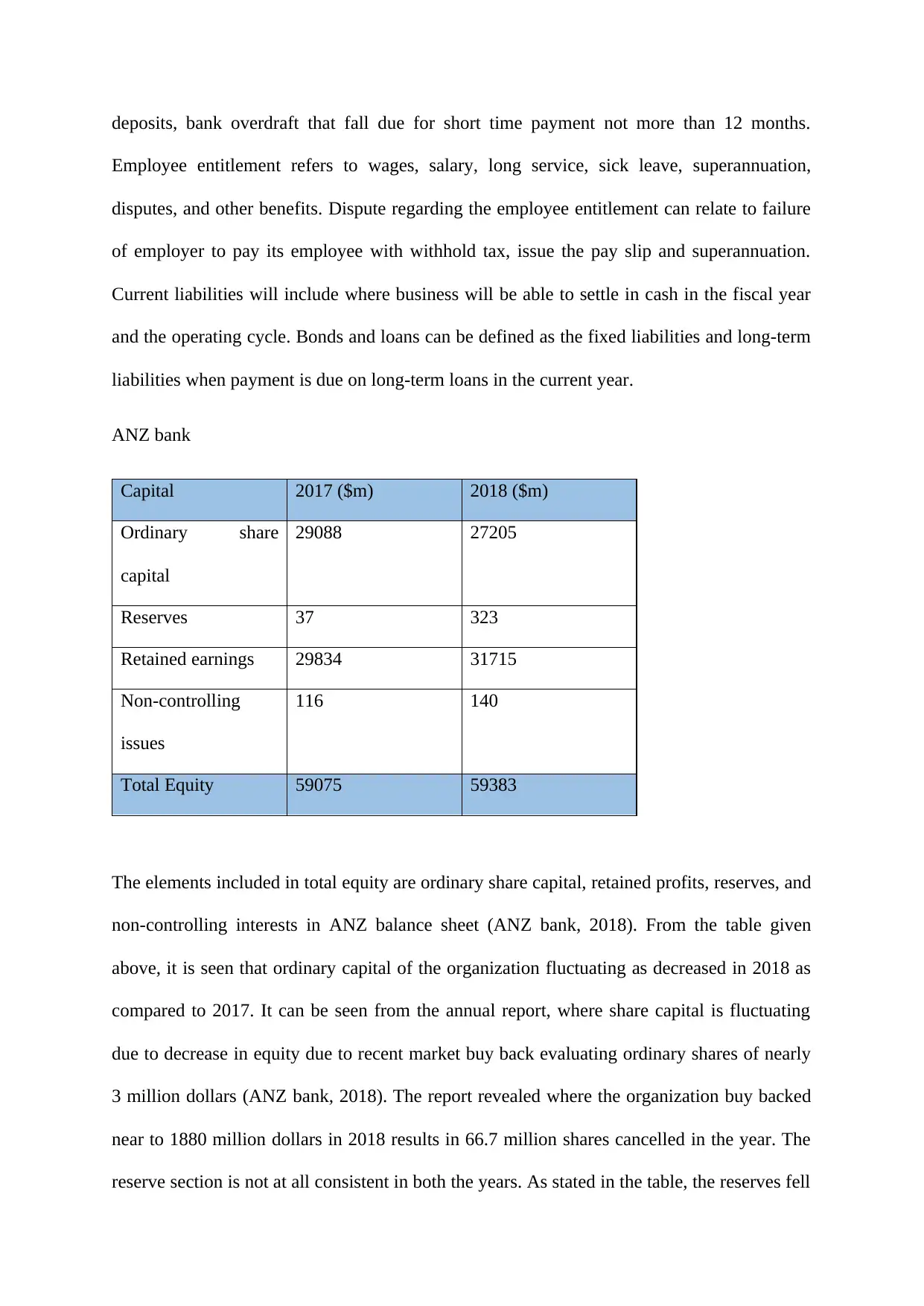
deposits, bank overdraft that fall due for short time payment not more than 12 months.
Employee entitlement refers to wages, salary, long service, sick leave, superannuation,
disputes, and other benefits. Dispute regarding the employee entitlement can relate to failure
of employer to pay its employee with withhold tax, issue the pay slip and superannuation.
Current liabilities will include where business will be able to settle in cash in the fiscal year
and the operating cycle. Bonds and loans can be defined as the fixed liabilities and long-term
liabilities when payment is due on long-term loans in the current year.
ANZ bank
Capital 2017 ($m) 2018 ($m)
Ordinary share
capital
29088 27205
Reserves 37 323
Retained earnings 29834 31715
Non-controlling
issues
116 140
Total Equity 59075 59383
The elements included in total equity are ordinary share capital, retained profits, reserves, and
non-controlling interests in ANZ balance sheet (ANZ bank, 2018). From the table given
above, it is seen that ordinary capital of the organization fluctuating as decreased in 2018 as
compared to 2017. It can be seen from the annual report, where share capital is fluctuating
due to decrease in equity due to recent market buy back evaluating ordinary shares of nearly
3 million dollars (ANZ bank, 2018). The report revealed where the organization buy backed
near to 1880 million dollars in 2018 results in 66.7 million shares cancelled in the year. The
reserve section is not at all consistent in both the years. As stated in the table, the reserves fell
Employee entitlement refers to wages, salary, long service, sick leave, superannuation,
disputes, and other benefits. Dispute regarding the employee entitlement can relate to failure
of employer to pay its employee with withhold tax, issue the pay slip and superannuation.
Current liabilities will include where business will be able to settle in cash in the fiscal year
and the operating cycle. Bonds and loans can be defined as the fixed liabilities and long-term
liabilities when payment is due on long-term loans in the current year.
ANZ bank
Capital 2017 ($m) 2018 ($m)
Ordinary share
capital
29088 27205
Reserves 37 323
Retained earnings 29834 31715
Non-controlling
issues
116 140
Total Equity 59075 59383
The elements included in total equity are ordinary share capital, retained profits, reserves, and
non-controlling interests in ANZ balance sheet (ANZ bank, 2018). From the table given
above, it is seen that ordinary capital of the organization fluctuating as decreased in 2018 as
compared to 2017. It can be seen from the annual report, where share capital is fluctuating
due to decrease in equity due to recent market buy back evaluating ordinary shares of nearly
3 million dollars (ANZ bank, 2018). The report revealed where the organization buy backed
near to 1880 million dollars in 2018 results in 66.7 million shares cancelled in the year. The
reserve section is not at all consistent in both the years. As stated in the table, the reserves fell
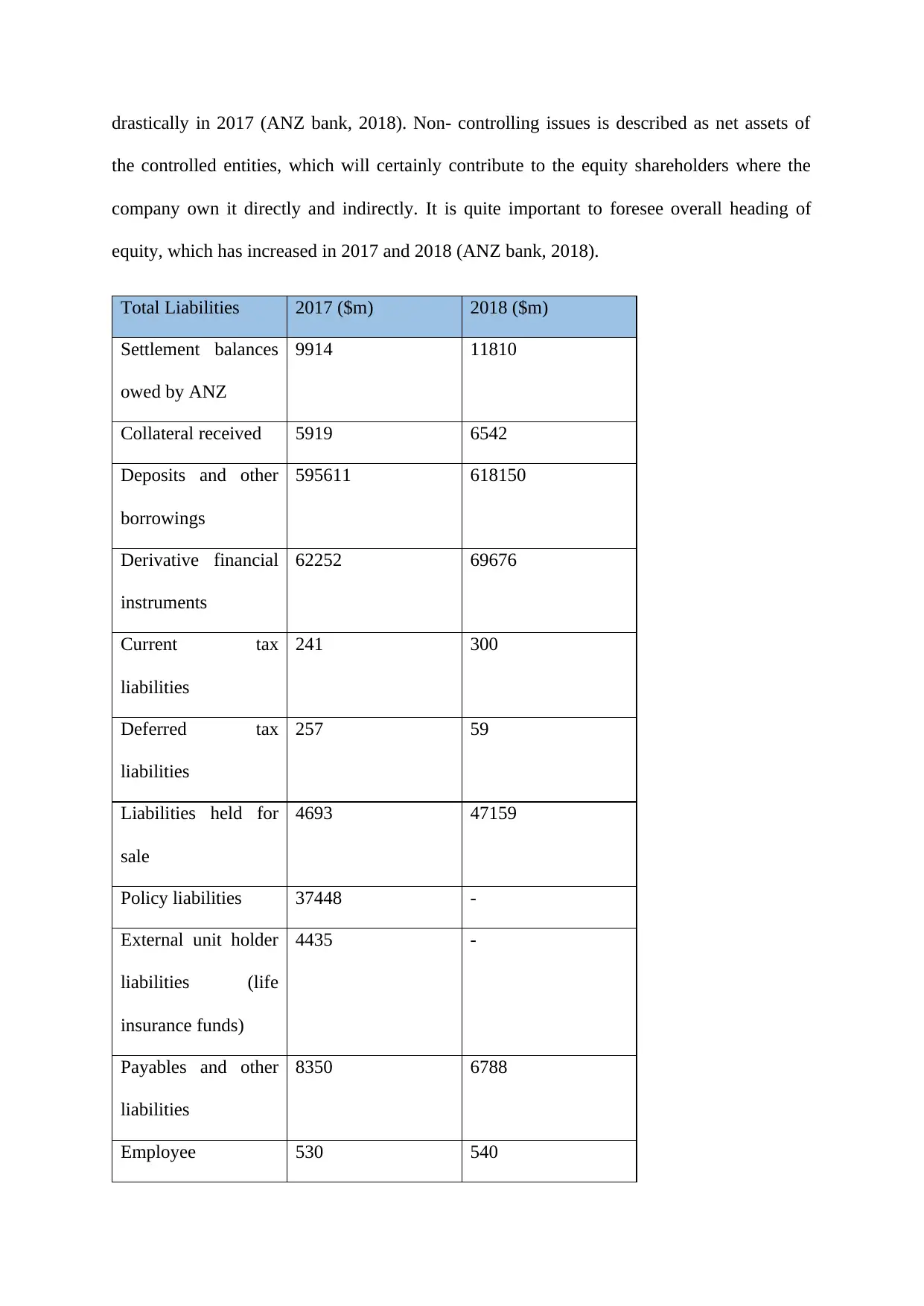
drastically in 2017 (ANZ bank, 2018). Non- controlling issues is described as net assets of
the controlled entities, which will certainly contribute to the equity shareholders where the
company own it directly and indirectly. It is quite important to foresee overall heading of
equity, which has increased in 2017 and 2018 (ANZ bank, 2018).
Total Liabilities 2017 ($m) 2018 ($m)
Settlement balances
owed by ANZ
9914 11810
Collateral received 5919 6542
Deposits and other
borrowings
595611 618150
Derivative financial
instruments
62252 69676
Current tax
liabilities
241 300
Deferred tax
liabilities
257 59
Liabilities held for
sale
4693 47159
Policy liabilities 37448 -
External unit holder
liabilities (life
insurance funds)
4435 -
Payables and other
liabilities
8350 6788
Employee 530 540
the controlled entities, which will certainly contribute to the equity shareholders where the
company own it directly and indirectly. It is quite important to foresee overall heading of
equity, which has increased in 2017 and 2018 (ANZ bank, 2018).
Total Liabilities 2017 ($m) 2018 ($m)
Settlement balances
owed by ANZ
9914 11810
Collateral received 5919 6542
Deposits and other
borrowings
595611 618150
Derivative financial
instruments
62252 69676
Current tax
liabilities
241 300
Deferred tax
liabilities
257 59
Liabilities held for
sale
4693 47159
Policy liabilities 37448 -
External unit holder
liabilities (life
insurance funds)
4435 -
Payables and other
liabilities
8350 6788
Employee 530 540
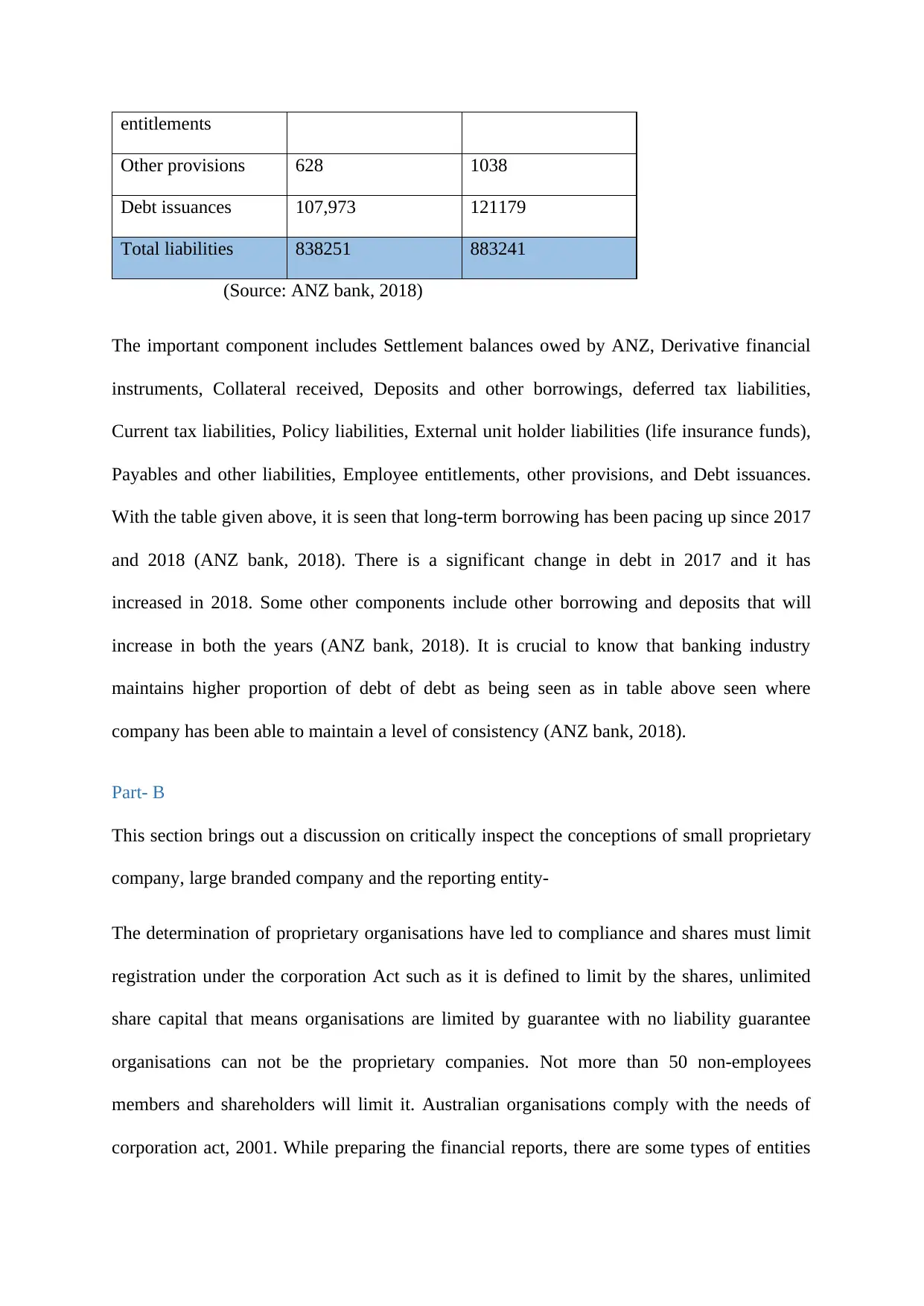
entitlements
Other provisions 628 1038
Debt issuances 107,973 121179
Total liabilities 838251 883241
(Source: ANZ bank, 2018)
The important component includes Settlement balances owed by ANZ, Derivative financial
instruments, Collateral received, Deposits and other borrowings, deferred tax liabilities,
Current tax liabilities, Policy liabilities, External unit holder liabilities (life insurance funds),
Payables and other liabilities, Employee entitlements, other provisions, and Debt issuances.
With the table given above, it is seen that long-term borrowing has been pacing up since 2017
and 2018 (ANZ bank, 2018). There is a significant change in debt in 2017 and it has
increased in 2018. Some other components include other borrowing and deposits that will
increase in both the years (ANZ bank, 2018). It is crucial to know that banking industry
maintains higher proportion of debt of debt as being seen as in table above seen where
company has been able to maintain a level of consistency (ANZ bank, 2018).
Part- B
This section brings out a discussion on critically inspect the conceptions of small proprietary
company, large branded company and the reporting entity-
The determination of proprietary organisations have led to compliance and shares must limit
registration under the corporation Act such as it is defined to limit by the shares, unlimited
share capital that means organisations are limited by guarantee with no liability guarantee
organisations can not be the proprietary companies. Not more than 50 non-employees
members and shareholders will limit it. Australian organisations comply with the needs of
corporation act, 2001. While preparing the financial reports, there are some types of entities
Other provisions 628 1038
Debt issuances 107,973 121179
Total liabilities 838251 883241
(Source: ANZ bank, 2018)
The important component includes Settlement balances owed by ANZ, Derivative financial
instruments, Collateral received, Deposits and other borrowings, deferred tax liabilities,
Current tax liabilities, Policy liabilities, External unit holder liabilities (life insurance funds),
Payables and other liabilities, Employee entitlements, other provisions, and Debt issuances.
With the table given above, it is seen that long-term borrowing has been pacing up since 2017
and 2018 (ANZ bank, 2018). There is a significant change in debt in 2017 and it has
increased in 2018. Some other components include other borrowing and deposits that will
increase in both the years (ANZ bank, 2018). It is crucial to know that banking industry
maintains higher proportion of debt of debt as being seen as in table above seen where
company has been able to maintain a level of consistency (ANZ bank, 2018).
Part- B
This section brings out a discussion on critically inspect the conceptions of small proprietary
company, large branded company and the reporting entity-
The determination of proprietary organisations have led to compliance and shares must limit
registration under the corporation Act such as it is defined to limit by the shares, unlimited
share capital that means organisations are limited by guarantee with no liability guarantee
organisations can not be the proprietary companies. Not more than 50 non-employees
members and shareholders will limit it. Australian organisations comply with the needs of
corporation act, 2001. While preparing the financial reports, there are some types of entities
Secure Best Marks with AI Grader
Need help grading? Try our AI Grader for instant feedback on your assignments.
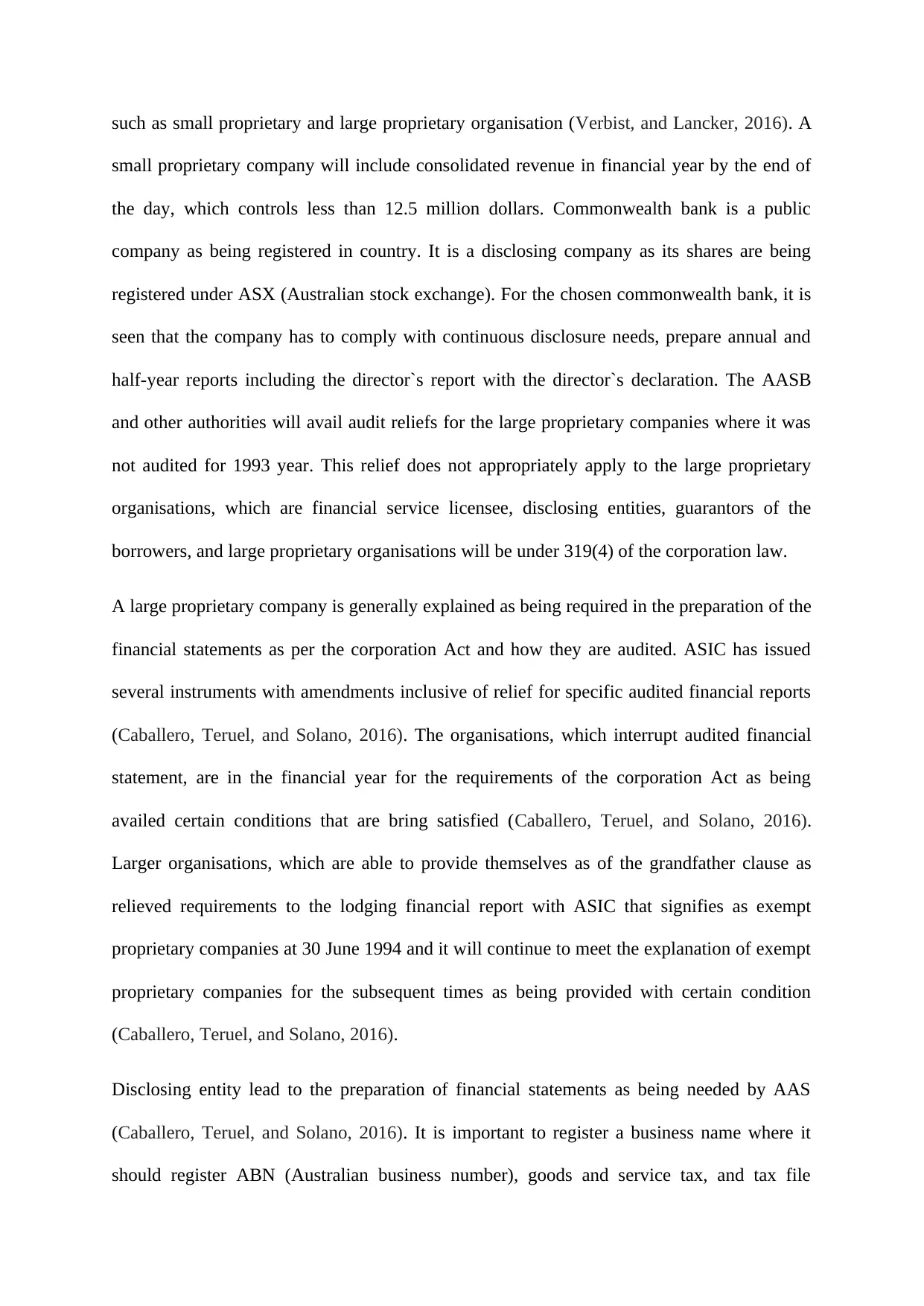
such as small proprietary and large proprietary organisation (Verbist, and Lancker, 2016). A
small proprietary company will include consolidated revenue in financial year by the end of
the day, which controls less than 12.5 million dollars. Commonwealth bank is a public
company as being registered in country. It is a disclosing company as its shares are being
registered under ASX (Australian stock exchange). For the chosen commonwealth bank, it is
seen that the company has to comply with continuous disclosure needs, prepare annual and
half-year reports including the director`s report with the director`s declaration. The AASB
and other authorities will avail audit reliefs for the large proprietary companies where it was
not audited for 1993 year. This relief does not appropriately apply to the large proprietary
organisations, which are financial service licensee, disclosing entities, guarantors of the
borrowers, and large proprietary organisations will be under 319(4) of the corporation law.
A large proprietary company is generally explained as being required in the preparation of the
financial statements as per the corporation Act and how they are audited. ASIC has issued
several instruments with amendments inclusive of relief for specific audited financial reports
(Caballero, Teruel, and Solano, 2016). The organisations, which interrupt audited financial
statement, are in the financial year for the requirements of the corporation Act as being
availed certain conditions that are bring satisfied (Caballero, Teruel, and Solano, 2016).
Larger organisations, which are able to provide themselves as of the grandfather clause as
relieved requirements to the lodging financial report with ASIC that signifies as exempt
proprietary companies at 30 June 1994 and it will continue to meet the explanation of exempt
proprietary companies for the subsequent times as being provided with certain condition
(Caballero, Teruel, and Solano, 2016).
Disclosing entity lead to the preparation of financial statements as being needed by AAS
(Caballero, Teruel, and Solano, 2016). It is important to register a business name where it
should register ABN (Australian business number), goods and service tax, and tax file
small proprietary company will include consolidated revenue in financial year by the end of
the day, which controls less than 12.5 million dollars. Commonwealth bank is a public
company as being registered in country. It is a disclosing company as its shares are being
registered under ASX (Australian stock exchange). For the chosen commonwealth bank, it is
seen that the company has to comply with continuous disclosure needs, prepare annual and
half-year reports including the director`s report with the director`s declaration. The AASB
and other authorities will avail audit reliefs for the large proprietary companies where it was
not audited for 1993 year. This relief does not appropriately apply to the large proprietary
organisations, which are financial service licensee, disclosing entities, guarantors of the
borrowers, and large proprietary organisations will be under 319(4) of the corporation law.
A large proprietary company is generally explained as being required in the preparation of the
financial statements as per the corporation Act and how they are audited. ASIC has issued
several instruments with amendments inclusive of relief for specific audited financial reports
(Caballero, Teruel, and Solano, 2016). The organisations, which interrupt audited financial
statement, are in the financial year for the requirements of the corporation Act as being
availed certain conditions that are bring satisfied (Caballero, Teruel, and Solano, 2016).
Larger organisations, which are able to provide themselves as of the grandfather clause as
relieved requirements to the lodging financial report with ASIC that signifies as exempt
proprietary companies at 30 June 1994 and it will continue to meet the explanation of exempt
proprietary companies for the subsequent times as being provided with certain condition
(Caballero, Teruel, and Solano, 2016).
Disclosing entity lead to the preparation of financial statements as being needed by AAS
(Caballero, Teruel, and Solano, 2016). It is important to register a business name where it
should register ABN (Australian business number), goods and service tax, and tax file
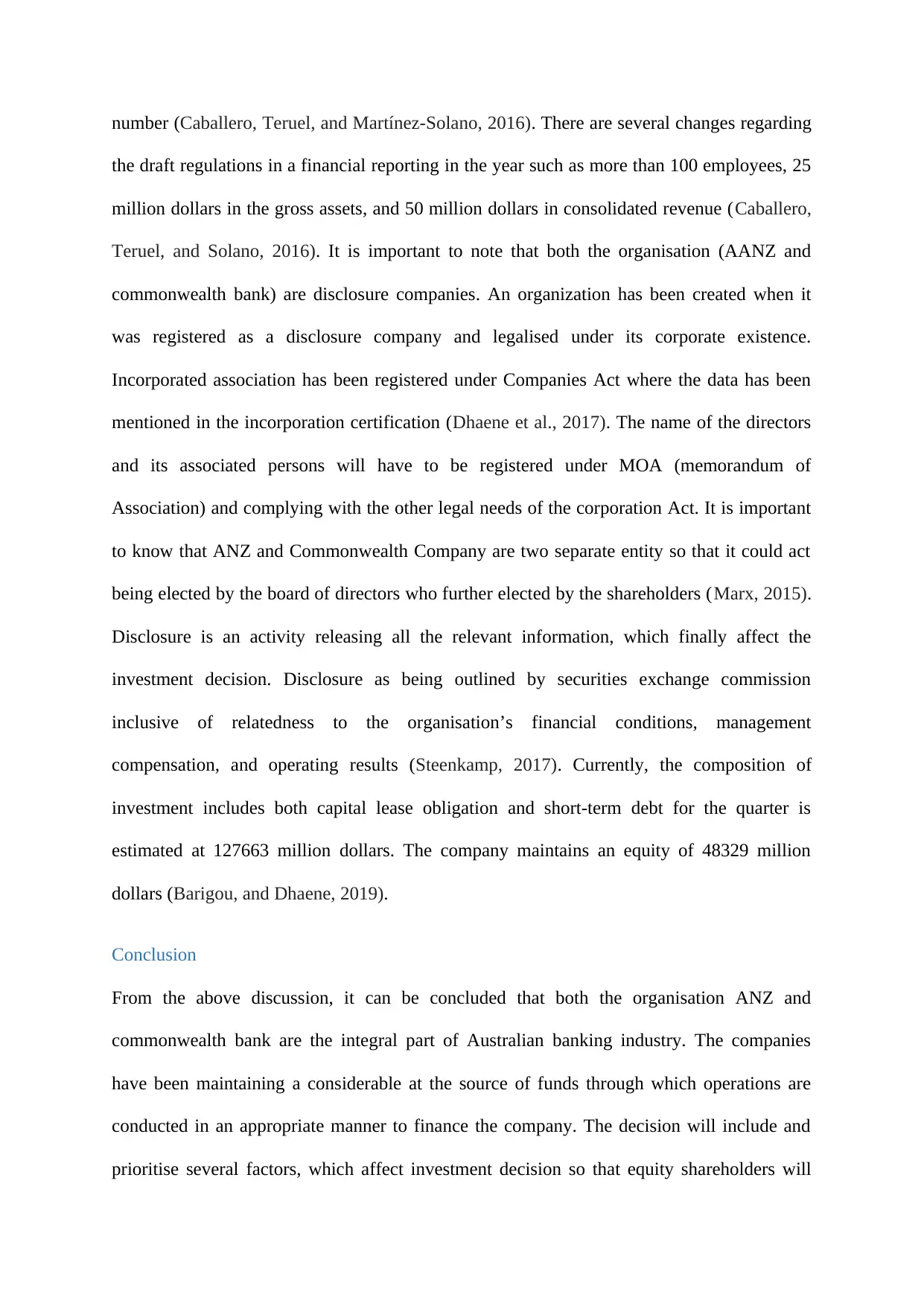
number (Caballero, Teruel, and Martínez-Solano, 2016). There are several changes regarding
the draft regulations in a financial reporting in the year such as more than 100 employees, 25
million dollars in the gross assets, and 50 million dollars in consolidated revenue (Caballero,
Teruel, and Solano, 2016). It is important to note that both the organisation (AANZ and
commonwealth bank) are disclosure companies. An organization has been created when it
was registered as a disclosure company and legalised under its corporate existence.
Incorporated association has been registered under Companies Act where the data has been
mentioned in the incorporation certification (Dhaene et al., 2017). The name of the directors
and its associated persons will have to be registered under MOA (memorandum of
Association) and complying with the other legal needs of the corporation Act. It is important
to know that ANZ and Commonwealth Company are two separate entity so that it could act
being elected by the board of directors who further elected by the shareholders (Marx, 2015).
Disclosure is an activity releasing all the relevant information, which finally affect the
investment decision. Disclosure as being outlined by securities exchange commission
inclusive of relatedness to the organisation’s financial conditions, management
compensation, and operating results (Steenkamp, 2017). Currently, the composition of
investment includes both capital lease obligation and short-term debt for the quarter is
estimated at 127663 million dollars. The company maintains an equity of 48329 million
dollars (Barigou, and Dhaene, 2019).
Conclusion
From the above discussion, it can be concluded that both the organisation ANZ and
commonwealth bank are the integral part of Australian banking industry. The companies
have been maintaining a considerable at the source of funds through which operations are
conducted in an appropriate manner to finance the company. The decision will include and
prioritise several factors, which affect investment decision so that equity shareholders will
the draft regulations in a financial reporting in the year such as more than 100 employees, 25
million dollars in the gross assets, and 50 million dollars in consolidated revenue (Caballero,
Teruel, and Solano, 2016). It is important to note that both the organisation (AANZ and
commonwealth bank) are disclosure companies. An organization has been created when it
was registered as a disclosure company and legalised under its corporate existence.
Incorporated association has been registered under Companies Act where the data has been
mentioned in the incorporation certification (Dhaene et al., 2017). The name of the directors
and its associated persons will have to be registered under MOA (memorandum of
Association) and complying with the other legal needs of the corporation Act. It is important
to know that ANZ and Commonwealth Company are two separate entity so that it could act
being elected by the board of directors who further elected by the shareholders (Marx, 2015).
Disclosure is an activity releasing all the relevant information, which finally affect the
investment decision. Disclosure as being outlined by securities exchange commission
inclusive of relatedness to the organisation’s financial conditions, management
compensation, and operating results (Steenkamp, 2017). Currently, the composition of
investment includes both capital lease obligation and short-term debt for the quarter is
estimated at 127663 million dollars. The company maintains an equity of 48329 million
dollars (Barigou, and Dhaene, 2019).
Conclusion
From the above discussion, it can be concluded that both the organisation ANZ and
commonwealth bank are the integral part of Australian banking industry. The companies
have been maintaining a considerable at the source of funds through which operations are
conducted in an appropriate manner to finance the company. The decision will include and
prioritise several factors, which affect investment decision so that equity shareholders will
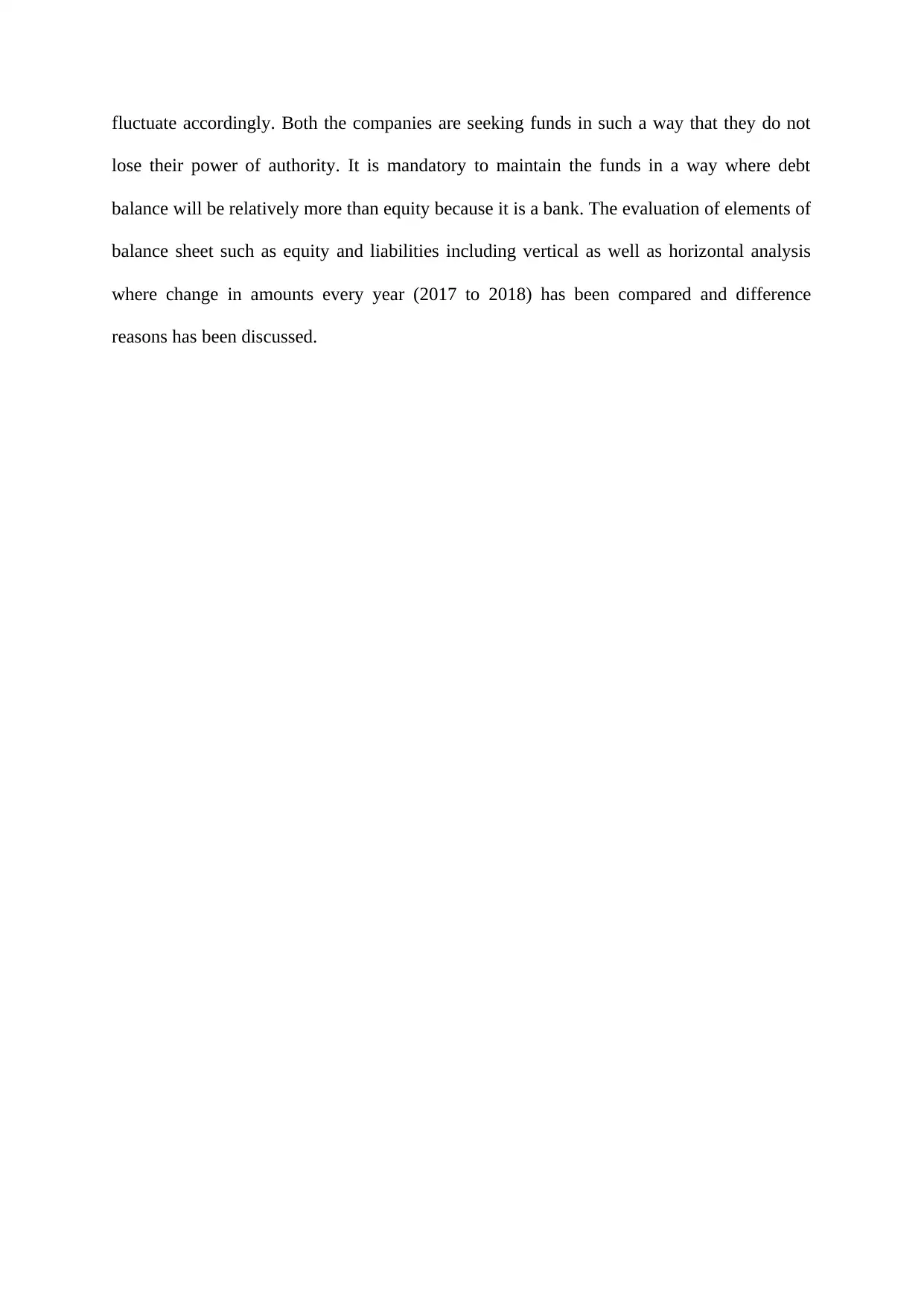
fluctuate accordingly. Both the companies are seeking funds in such a way that they do not
lose their power of authority. It is mandatory to maintain the funds in a way where debt
balance will be relatively more than equity because it is a bank. The evaluation of elements of
balance sheet such as equity and liabilities including vertical as well as horizontal analysis
where change in amounts every year (2017 to 2018) has been compared and difference
reasons has been discussed.
lose their power of authority. It is mandatory to maintain the funds in a way where debt
balance will be relatively more than equity because it is a bank. The evaluation of elements of
balance sheet such as equity and liabilities including vertical as well as horizontal analysis
where change in amounts every year (2017 to 2018) has been compared and difference
reasons has been discussed.
Paraphrase This Document
Need a fresh take? Get an instant paraphrase of this document with our AI Paraphraser
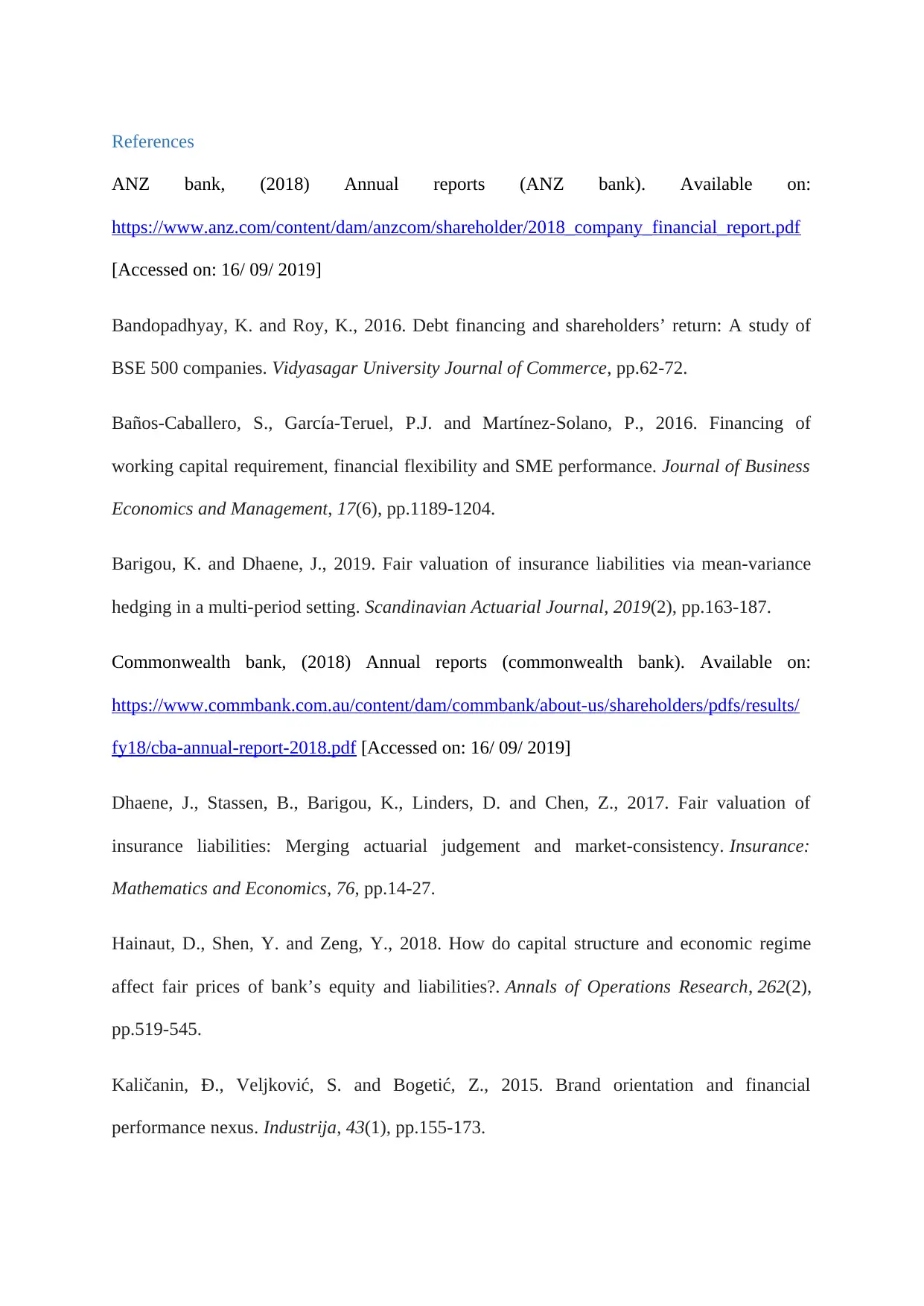
References
ANZ bank, (2018) Annual reports (ANZ bank). Available on:
https://www.anz.com/content/dam/anzcom/shareholder/2018_company_financial_report.pdf
[Accessed on: 16/ 09/ 2019]
Bandopadhyay, K. and Roy, K., 2016. Debt financing and shareholders’ return: A study of
BSE 500 companies. Vidyasagar University Journal of Commerce, pp.62-72.
Baños-Caballero, S., García-Teruel, P.J. and Martínez-Solano, P., 2016. Financing of
working capital requirement, financial flexibility and SME performance. Journal of Business
Economics and Management, 17(6), pp.1189-1204.
Barigou, K. and Dhaene, J., 2019. Fair valuation of insurance liabilities via mean-variance
hedging in a multi-period setting. Scandinavian Actuarial Journal, 2019(2), pp.163-187.
Commonwealth bank, (2018) Annual reports (commonwealth bank). Available on:
https://www.commbank.com.au/content/dam/commbank/about-us/shareholders/pdfs/results/
fy18/cba-annual-report-2018.pdf [Accessed on: 16/ 09/ 2019]
Dhaene, J., Stassen, B., Barigou, K., Linders, D. and Chen, Z., 2017. Fair valuation of
insurance liabilities: Merging actuarial judgement and market-consistency. Insurance:
Mathematics and Economics, 76, pp.14-27.
Hainaut, D., Shen, Y. and Zeng, Y., 2018. How do capital structure and economic regime
affect fair prices of bank’s equity and liabilities?. Annals of Operations Research, 262(2),
pp.519-545.
Kaličanin, Đ., Veljković, S. and Bogetić, Z., 2015. Brand orientation and financial
performance nexus. Industrija, 43(1), pp.155-173.
ANZ bank, (2018) Annual reports (ANZ bank). Available on:
https://www.anz.com/content/dam/anzcom/shareholder/2018_company_financial_report.pdf
[Accessed on: 16/ 09/ 2019]
Bandopadhyay, K. and Roy, K., 2016. Debt financing and shareholders’ return: A study of
BSE 500 companies. Vidyasagar University Journal of Commerce, pp.62-72.
Baños-Caballero, S., García-Teruel, P.J. and Martínez-Solano, P., 2016. Financing of
working capital requirement, financial flexibility and SME performance. Journal of Business
Economics and Management, 17(6), pp.1189-1204.
Barigou, K. and Dhaene, J., 2019. Fair valuation of insurance liabilities via mean-variance
hedging in a multi-period setting. Scandinavian Actuarial Journal, 2019(2), pp.163-187.
Commonwealth bank, (2018) Annual reports (commonwealth bank). Available on:
https://www.commbank.com.au/content/dam/commbank/about-us/shareholders/pdfs/results/
fy18/cba-annual-report-2018.pdf [Accessed on: 16/ 09/ 2019]
Dhaene, J., Stassen, B., Barigou, K., Linders, D. and Chen, Z., 2017. Fair valuation of
insurance liabilities: Merging actuarial judgement and market-consistency. Insurance:
Mathematics and Economics, 76, pp.14-27.
Hainaut, D., Shen, Y. and Zeng, Y., 2018. How do capital structure and economic regime
affect fair prices of bank’s equity and liabilities?. Annals of Operations Research, 262(2),
pp.519-545.
Kaličanin, Đ., Veljković, S. and Bogetić, Z., 2015. Brand orientation and financial
performance nexus. Industrija, 43(1), pp.155-173.
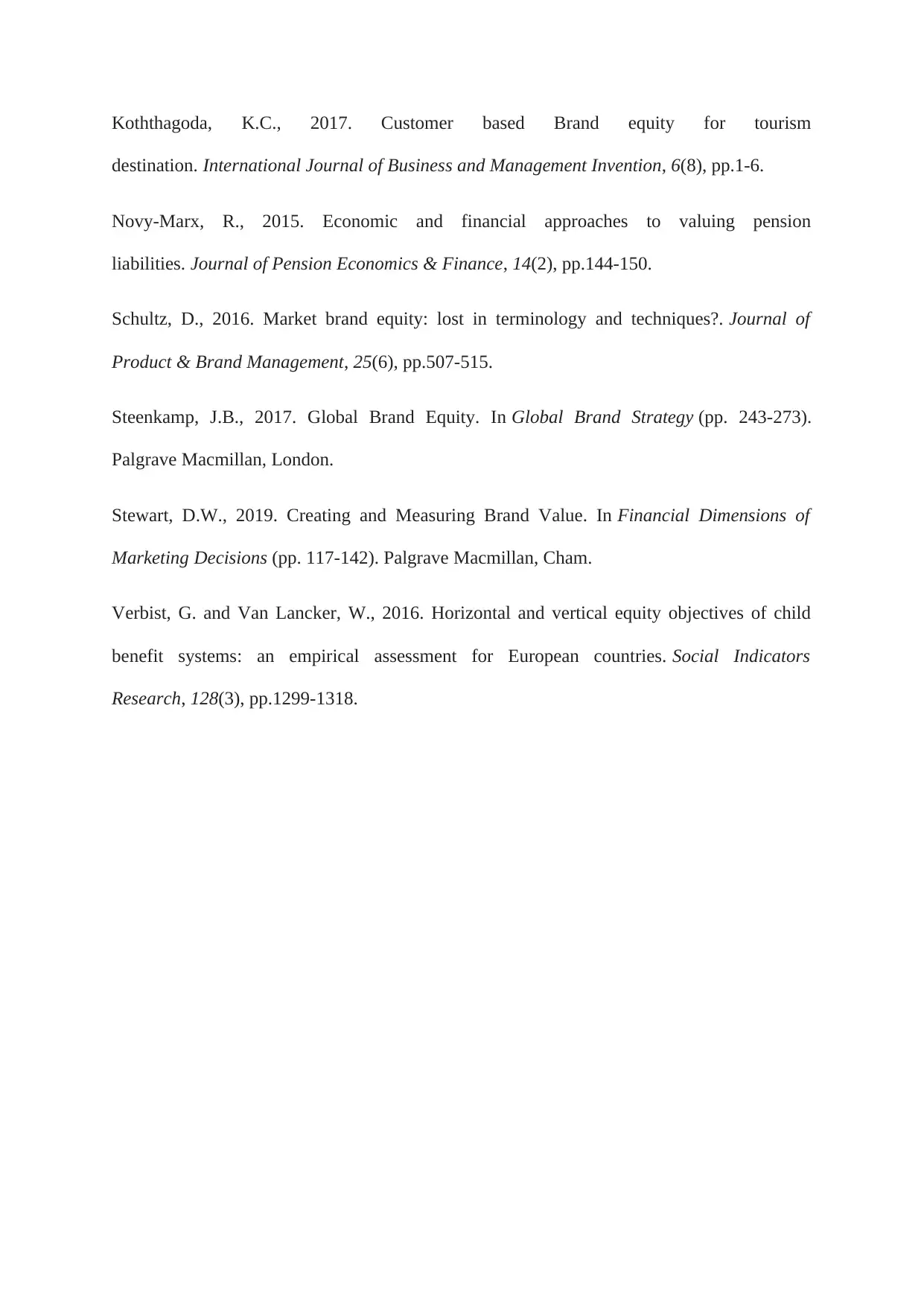
Koththagoda, K.C., 2017. Customer based Brand equity for tourism
destination. International Journal of Business and Management Invention, 6(8), pp.1-6.
Novy-Marx, R., 2015. Economic and financial approaches to valuing pension
liabilities. Journal of Pension Economics & Finance, 14(2), pp.144-150.
Schultz, D., 2016. Market brand equity: lost in terminology and techniques?. Journal of
Product & Brand Management, 25(6), pp.507-515.
Steenkamp, J.B., 2017. Global Brand Equity. In Global Brand Strategy (pp. 243-273).
Palgrave Macmillan, London.
Stewart, D.W., 2019. Creating and Measuring Brand Value. In Financial Dimensions of
Marketing Decisions (pp. 117-142). Palgrave Macmillan, Cham.
Verbist, G. and Van Lancker, W., 2016. Horizontal and vertical equity objectives of child
benefit systems: an empirical assessment for European countries. Social Indicators
Research, 128(3), pp.1299-1318.
destination. International Journal of Business and Management Invention, 6(8), pp.1-6.
Novy-Marx, R., 2015. Economic and financial approaches to valuing pension
liabilities. Journal of Pension Economics & Finance, 14(2), pp.144-150.
Schultz, D., 2016. Market brand equity: lost in terminology and techniques?. Journal of
Product & Brand Management, 25(6), pp.507-515.
Steenkamp, J.B., 2017. Global Brand Equity. In Global Brand Strategy (pp. 243-273).
Palgrave Macmillan, London.
Stewart, D.W., 2019. Creating and Measuring Brand Value. In Financial Dimensions of
Marketing Decisions (pp. 117-142). Palgrave Macmillan, Cham.
Verbist, G. and Van Lancker, W., 2016. Horizontal and vertical equity objectives of child
benefit systems: an empirical assessment for European countries. Social Indicators
Research, 128(3), pp.1299-1318.
1 out of 15
Related Documents
Your All-in-One AI-Powered Toolkit for Academic Success.
+13062052269
info@desklib.com
Available 24*7 on WhatsApp / Email
![[object Object]](/_next/static/media/star-bottom.7253800d.svg)
Unlock your academic potential
© 2024 | Zucol Services PVT LTD | All rights reserved.



